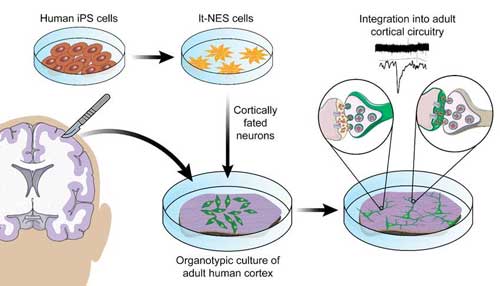| Aug 27, 2020 |
Researchers create neurons that can be integrated into human brain tissue
|
|
(Nanowerk News) A team of researchers from the Institute of Neurosciences (UBneuro) and Institute of Complex Systems (UBICS) of the University of Barcelona has demonstrated that neurons can be generated from skin cells of a human donor using a cellular reprograming technology. According to the obtained results, these neurons are able to integrate into human brain tissue when transplanted into a small piece of the brain from a human donor.
|
|
Using state-of-the-art technology including virus-based monosynaptic neuronal tracing and electrophysiological recordings, researchers demonstrated that grafted cells integrate into an already stablished neuronal network –present in a slice of brain cortex from a human donor–, receiving inputs and stablishing synaptic contacts with the neurons of the slice.
|
 |
| Cortically fated neuroepithelial-like stem (lt-NES) cells, which are able to form functional synaptic networks in cell culture, differentiate to mature layer-specific cortical neurons when transplanted ex vivo onto organotypic cultures of adult human cortex. (Image courtesy of the researchers)
|
|
“This is a very important advance in the treatment of brain damage, because most of the studies carried out to demonstrate the feasibility of stem cell transplantation as therapy have been conducted using animal models, such as mice or rats. In this study, it has been established a method to prove that these therapies are also efficient when transplanting human cells into human tissue”, notes Daniel Tornero, professor at the University of Barcelona and member of the Institute of Neurosciences of the UB. “Moreover, the fact that grafted cells can be obtained from human skin cells allow for allogenic transplantation, i.e. transplantation of cells obtained from the same patient, avoiding graft rejection and ethical concerns associated with this kind of therapies”, adds Tornero.
|
|
The researcher notes that thanks to the collaboration with Professor Jordi Soriano, from the Faculty of Physics of UB, they combined stem cell biology techniques with physical perspective in the analysis of neuronal network functionality. This collaboration allowed the researchers to reach a better understand the complexity of the experimental model and delineate future strategies for therapeutic treatments.
|
|
The study, published in the Journal Stem Cells Translational Medicine ("Grafted human pluripotent stem cell-derived cortical neurons integrate into adult human cortical neural circuitry"), has been carried out in collaboration with the laboratory of Professor Zaal Kokaia at the Lund Stem Cell Center (Sweden).
|

